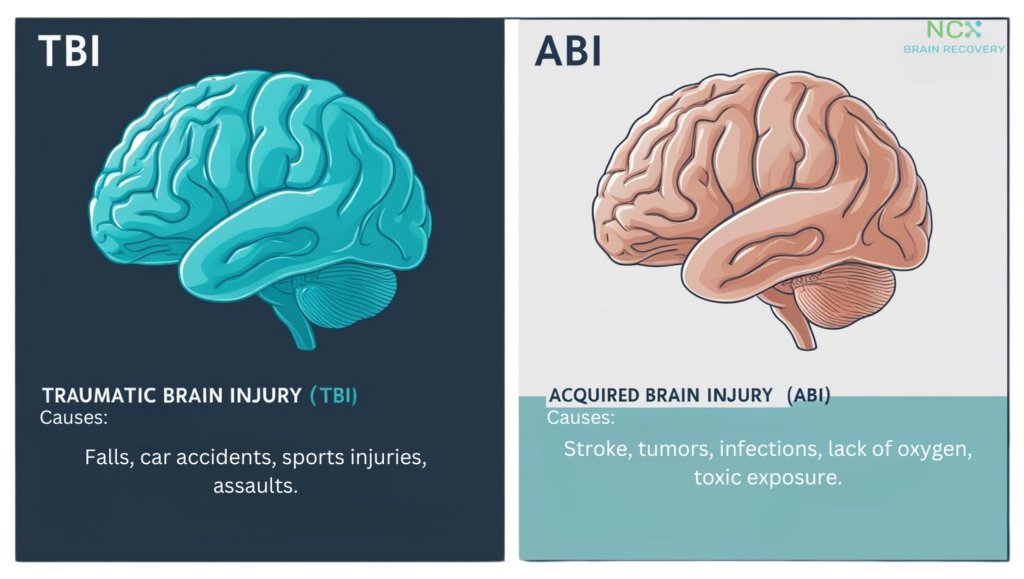March 2025 – Brain Injury Awareness Month
Every 9 seconds, someone in the United States sustains a brain injury. That’s more than 3.5 million people each year. Despite how common they are, brain injuries remain widely misunderstood. During Brain Injury Awareness Month, NCX Brain Recovery wants to shed light on the different types of brain injuries, their causes, symptoms, and the road to recovery.
Table of Contents
The Two Major Categories of Brain Injuries
Brain injuries are typically classified into two categories: Traumatic Brain Injuries (TBIs), caused by external physical forces, and Acquired Brain Injuries (ABIs), resulting from internal factors such as illnesses or medical conditions. Recognizing the distinctions between these types is important for accurate diagnosis and effective treatment.
Traumatic Brain Injuries (TBIs)
A traumatic brain injury occurs when an external force damages the brain. This can happen through direct impact, rapid acceleration/deceleration, or penetration of the skull.
Common Causes of TBIs:
- Falls (especially among children and older adults)
- Motor vehicle accidents
- Sports injuries
- Physical assaults
- Combat injuries
- Workplace accidents
Classification of TBIs
Mild TBI: Often called concussions, accounting for about 75% of all TBIs. Despite being termed “mild,” these injuries can significantly impact daily life. Many people with mild TBIs develop Post-Concussion Syndrome (PCS), with symptoms lasting weeks, months, or years.
Moderate TBI: Longer periods of unconsciousness or confusion with noticeable physical, cognitive, and behavioral changes.
Severe TBI: Extended periods of unconsciousness, significant memory loss, and long-term or permanent impairments.
Types of Traumatic Brain Injuries
- Concussions: Result from the brain being shaken within the skull. Effects can be long-lasting.
- Contusions: Bruises on the brain involving bleeding and swelling.
- Diffuse Axonal Injuries (DAI): Widespread damage to brain fibers from rapid shifting, often severe.
- Subdural Hematomas: Bleeding between the brain and its outer covering, which may require surgery.
- Epidural Hematomas: Bleeding between the skull and dura mater, often requiring emergency treatment.
- Penetrating Injuries: Objects penetrating the skull, causing direct brain damage.

Acquired Brain Injuries (ABIs)
Unlike TBIs, ABIs are caused by internal factors rather than external trauma.
Common Types of ABIs:
- Stroke: Interruption of blood flow to the brain causing rapid cell death.
- Anoxic Brain Injury: Complete deprivation of oxygen, from events like cardiac arrest or near-drowning.
- Hypoxic Brain Injury: Partial oxygen deprivation damaging brain cells.
- Brain Tumors: Tumors exerting pressure or invading brain tissue.
- Infectious Diseases: Conditions like encephalitis or meningitis causing significant damage.
- Toxic Exposure: Damage from toxins like lead or carbon monoxide.
- Metabolic Disorders: Conditions such as liver or kidney disease impacting brain function.
Comparing TBI and ABI
While TBIs and ABIs have different causes, both can lead to:
- Cognitive changes (memory, attention, processing)
- Physical symptoms (headaches, fatigue, coordination/balance issues, vision and sleep changes)
- Emotional and behavioral changes (mood swings, irritability)
- Communication difficulties
A primary difference is TBIs have a clear moment of injury, while ABIs may occur suddenly or gradually.
The Impact of Brain Injuries
Brain injuries affect more than just physical health—they impact every aspect of a person’s life, including:
- Returning to work or school
- Relationships and family dynamics
- Daily life management
- Financial stability
- Emotional health
While emotional trauma alone isn’t classified as an acquired brain injury, significant emotional stress or trauma can profoundly affect brain function, leading to cognitive, emotional, and physiological changes. Chronic stress or emotional trauma may alter brain chemistry, impacting memory, concentration, mood regulation, and overall mental health. It’s essential to recognize and treat emotional trauma seriously, often in collaboration with mental health professionals, as part of a comprehensive approach to brain health.
The Path to Recovery
Recovery is a complex, individual process influenced by injury type, severity, age, health, and treatment availability.
Common Traditional Rehabilitation Approaches:
- Physical Therapy: Improves movement, balance, and strength.
- Occupational Therapy: Helps with daily activities.
- Speech-Language Therapy: Addresses communication and language-related cognitive issues.
- Cognitive Rehabilitation: Improves memory, attention, and problem-solving skills.
- Psychological Support: Supports emotional coping and family adjustment.
The Role of Neuroplasticity
Neuroplasticity—the brain’s ability to reorganize itself—is essential for recovery. This natural mechanism allows the brain to form new connections and adapt after injury, enabling healthy brain areas to compensate for damaged ones.
Recent research has shown that targeted therapy can effectively stimulate neuroplasticity. In particular, multi-sensory approaches have demonstrated significant benefits when treating brain injuries. Multi-Sensory Therapy involves utilizing different senses simultaneously (for example, visually scanning while on a treadmill and recalling information). This integrated approach challenges multiple brain systems at once, potentially accelerating the recovery process.
At NCX Brain Recovery, our treatment programs are designed to harness neuroplasticity through intensive, personalized therapy that engages multiple sensory systems, supporting more comprehensive healing.
Prevention: The Best Protection
Simple safety measures can help prevent or reduce the severity of brain injuries:
- Wear helmets during sports activities.
- Always use seatbelts and appropriate child safety seats.
- Remove home tripping hazards.
- Install safety gates on stairs for young children.
- Maintain regular physical activity for balance and strength.
- Manage health conditions to reduce risk factors.
Conclusion
Understanding brain injuries is the first step toward effective prevention, treatment, and support. At NCX Brain Recovery, we offer specialized, compassionate care to support your unique recovery journey.
Works Cited
- Centers for Disease Control and Prevention (CDC). “Traumatic Brain Injury & Concussion: Potential Effects.” CDC.gov. Accessed March 2025.
- Brain Injury Association of America. “Understanding Brain Injury.” biausa.org. Accessed March 2025.
- National Institute of Neurological Disorders and Stroke (NINDS). “Traumatic Brain Injury: Hope Through Research.” ninds.nih.gov. Accessed March 2025.
- Mayo Clinic. “Traumatic Brain Injury.” mayoclinic.org. Accessed March 2025.
- Kleim, J.A. & Jones, T.A. “Principles of Experience-Dependent Neural Plasticity: Implications for Rehabilitation After Brain Damage.” Journal of Speech, Language, and Hearing Research. 2008.
- Sharma, N., Classen, J., & Cohen, L.G. “Neural plasticity and its contribution to functional recovery.” Handbook of Clinical Neurology. 2013.
